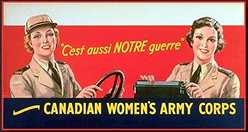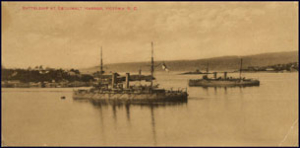The Canadian Forces Base (CFB) Esquimalt Naval & Military Museum is located at Naden on Canadian Forces Base Esquimalt, in the city of Victoria, which is situated on the southern tip of Vancouver Island, in the province of British Columbia, Canada.
The museum’s goal is to collect, preserve, interpret and display the history and heritage of the naval presence on Canada’s West Coast, and of the military on Southern Vancouver Island.
The museum exhibits focus on four distinct military groups that have made an impact on Canada’s history and left a lasting heritage:
Canada’s Navy on the West Coast
Towards the middle of the 19th century, the infant colony of British Columbia depended heavily on the Royal Navy for defence. There was an influx of restless adventurers and newcomers as a result of the Fraser River gold rush beginning in 1858. The navy helped to maintain law and order. During the same period, the navy helped settle a border dispute with the United States.
The museum follows the development of the naval presence on the West Coast of Canada. It traces this development from its beginnings in 1848 when Esquimalt Harbour – large, sheltered, and close to Victoria — began to be used as an anchorage. The Royal Navy kept Esquimalt as a base until 1905, when the Pacific Squadron was abolished and Canada took responsibility for defending its own coastline. The museum traces the ups – and downs – of the Canadian Navy with a series of exhibits, from the Navy’s formation in 1910, through the turbulence of two World Wars, the conflict in Korea, and beyond.
Canadian Women’s Army Corps (CWAC)
 On August 13, 1941, the Canadian Army received permission to found a women’s auxiliary corps. On August 29, 1941, just days after this permission was granted, the first Canadian Women’s Army Corps (CWAC) office was opened at Esquimalt’s Work Point Barracks, then the home of Military District 11 (BC) Headquarters.
On August 13, 1941, the Canadian Army received permission to found a women’s auxiliary corps. On August 29, 1941, just days after this permission was granted, the first Canadian Women’s Army Corps (CWAC) office was opened at Esquimalt’s Work Point Barracks, then the home of Military District 11 (BC) Headquarters.
During the Second World War, close to 22,000 women enlisted in the CWAC. By 1944, CWACs were being assigned to clerical and other duties in combat zones, a major departure from tradition (in previous wars, women were largely limited to serving as nurses; this was the first war in which they enlisted for duties other than nursing). Approximately 3,000 CWACs were sent overseas to Great Britain, Italy and Northwest Europe to support the invading Canadian Army. In May 1945, the Corps made up 2.8% of the total army complement.
The CWAC was disbanded in May 1946. In response to the Korean conflict, recruitment into the CWAC was reintroduced in 1951. The Corps was again disbanded in 1964.
Despite their contribution and abilities, women in military roles were not generally accepted, and were paid less than the basic pay allotted to men.
The CWAC contributed to the Allied victory, opened the door for future generations of Canadian service women, and raised questions about the equality of all women. Early in 2000, nearly 60 years after the first CWAC office was opened on the base, CFB Esquimalt Naval & Military Museum was pleased to become the museum representing the proud heritage of the CWAC.
The Women’s Royal Canadian Naval Service (WRCNS)
 The Navy was the last branch of the Canadian armed forces to accept women as recruits. The Women’s Royal Canadian Naval Service was not established until July 1942, much later than the Women’s Royal Naval Service in Britain (also known as ‘Wrens’). The Admiralty was slow to see the importance of bringing women into the RCN. When women were finally accepted, their roles were at first narrowly defined: WRCNS members were meant to perform routine clerical and administrative tasks, thus freeing men for sea duty. Eventually, though, Wrens trained as coders, switchboard, radar and teletype operators, and photographers, as well as secretaries and clerks. Nearly 1000 Wrens were sent overseas, many of them to Northern Ireland and Scotland.
The Navy was the last branch of the Canadian armed forces to accept women as recruits. The Women’s Royal Canadian Naval Service was not established until July 1942, much later than the Women’s Royal Naval Service in Britain (also known as ‘Wrens’). The Admiralty was slow to see the importance of bringing women into the RCN. When women were finally accepted, their roles were at first narrowly defined: WRCNS members were meant to perform routine clerical and administrative tasks, thus freeing men for sea duty. Eventually, though, Wrens trained as coders, switchboard, radar and teletype operators, and photographers, as well as secretaries and clerks. Nearly 1000 Wrens were sent overseas, many of them to Northern Ireland and Scotland.
The women received their three-week basic training at HMCS CONESTOGA in Ontario. Probationary Wrens were paid 90 cents a day, increasing to 95 cents a day on completion of basic training.
By the end of the Second World War, there were more than 6000 regular personnel and officers in the WRCNS. The fact that women today serve in all aspects of naval operation is mainly due to the hard work and adventurous spirit of the Wrens.
West Coast Defences
 In 1878, when a crisis in British-Russian affairs in the Balkans made war appear imminent, the first coast artillery batteries were positioned to protect Victoria and Esquimalt harbours. These coast defences stayed in existence for nearly 80 years until they were outmoded by new technology. In 1956, they were declared obsolete and the guns removed. Fort Rodd Hill National Historic Park, across the mouth of Esquimalt Harbour from the naval base, and the museum are endeavouring to keep this part of Canada’s heritage alive.
In 1878, when a crisis in British-Russian affairs in the Balkans made war appear imminent, the first coast artillery batteries were positioned to protect Victoria and Esquimalt harbours. These coast defences stayed in existence for nearly 80 years until they were outmoded by new technology. In 1956, they were declared obsolete and the guns removed. Fort Rodd Hill National Historic Park, across the mouth of Esquimalt Harbour from the naval base, and the museum are endeavouring to keep this part of Canada’s heritage alive.
Although the batteries which formed the coast defences of Victoria-Esquimalt were never called upon to repel an enemy, the threat of an attack was very real on more than one occasion. At such times, the value of these batteries was never in doubt. Their existence helped to ensure the security of the city of Victoria. By guarding the naval base at Esquimalt, the coast defences provided the warships of the Royal Navy and later of the Royal Canadian Navy with a secure anchorage from which they could sail to protect the entire coast of British Columbia.


